New Zealand Ecommerce Market Size
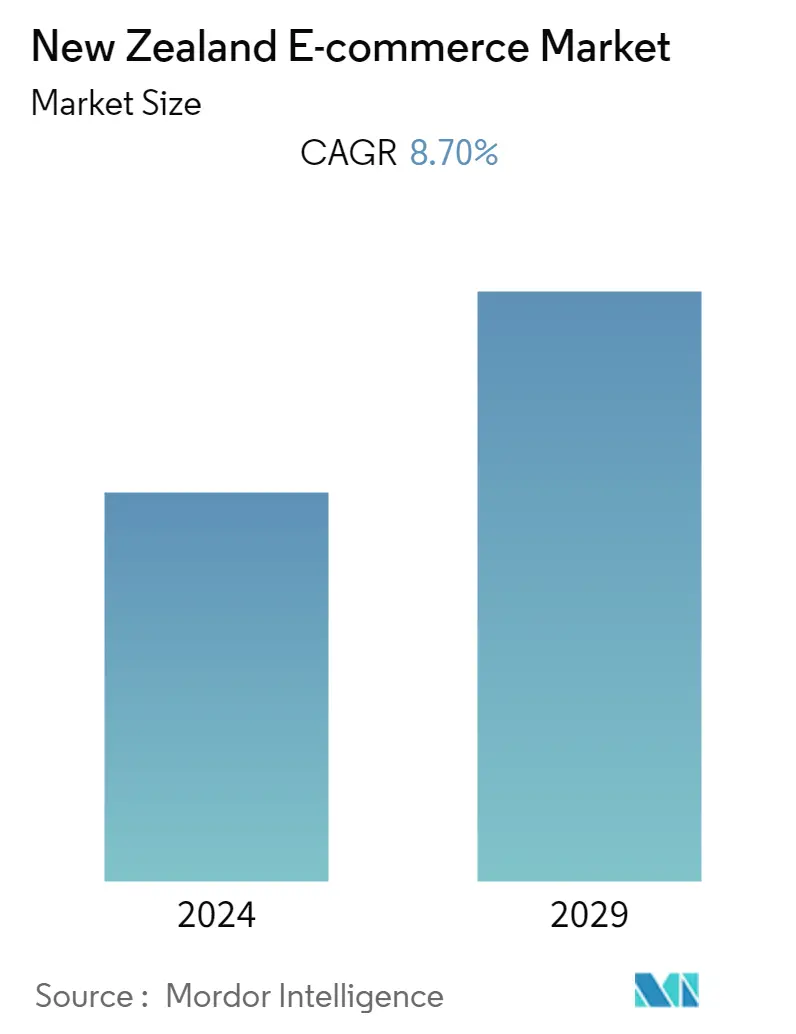
| Study Period | 2019 - 2029 |
| Base Year For Estimation | 2023 |
| Forecast Data Period | 2024 - 2029 |
| Historical Data Period | 2019 - 2022 |
| CAGR | 8.70 % |
| Market Concentration | Low |
Major Players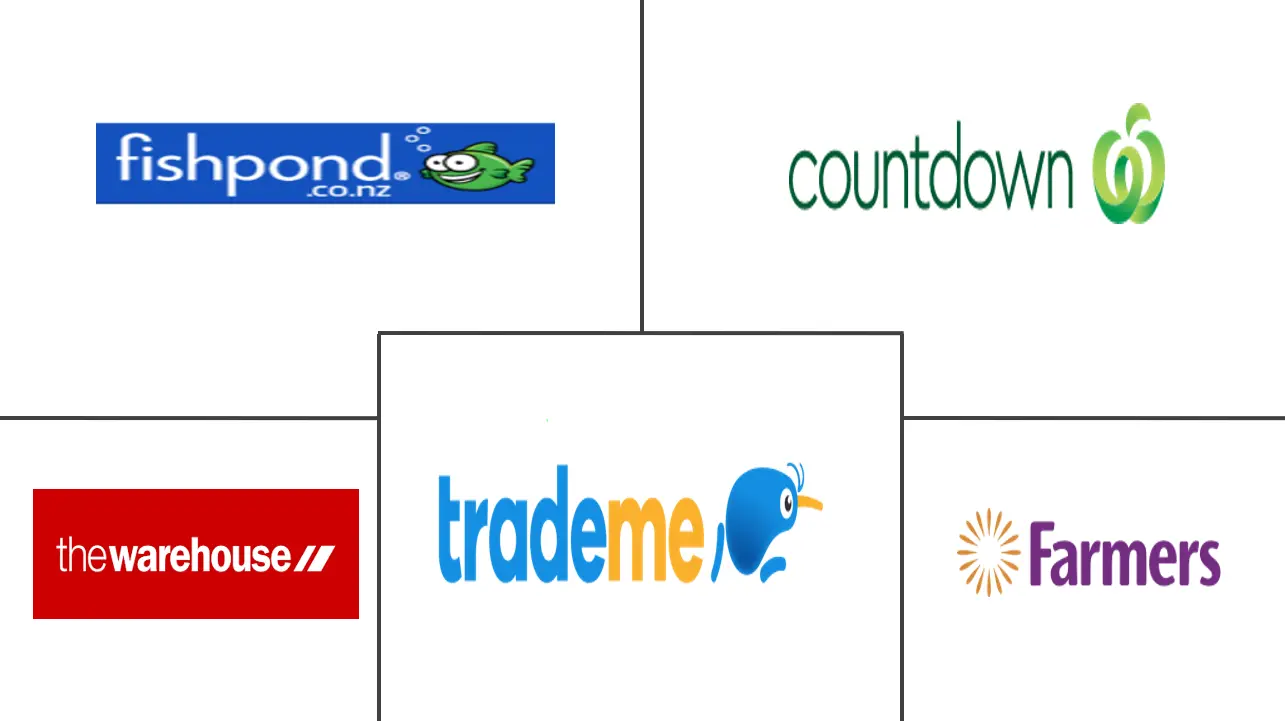
*Disclaimer: Major Players sorted in no particular order |
New Zealand Ecommerce Market Analysis
The New Zealand e-commerce market is expected to register a CAGR of 8.7% during the period 2022-2027. The primary factor driving the growth of the market in the region is the growing online spending and high smartphone penetration, among others.
- The New Zealand E-commerce market has been transforming rapidly over the past few years. Various factors boost the growth of the E-commerce market in the region, including higher smartphone penetration, increasing shopping frequency, and positive consumer behavior toward online shopping.
- Card payments are the most popular method for E-commerce transactions in the region. However, in the past few years, there have been significant shifts toward Buy Now Pay Later payment methods. As per New Zealand Post, Buy Now Pay Later services in the region grew by 49% in Q1 2021. Furthermore, the service is growing most rapidly among young people in New Zealand.
- As per New Zealand Post, in 2020, older age groups experiencing high levels of online retail growth in terms of their frequency and size of the spend. Then in 2021, the 40-65 years group spent 20% more, and the 65+ age group was also up 14%. Again, these trends will continue throughout the near future. It shows that any assumptions about older shoppers disliking E-commerce are growing increasingly untrue in the region. Further, older shoppers are expected to boost the market over the forecast period.
- Non-resident United States E-commerce companies selling online to New Zealand consumers must comply with local regulations, including consumer and tax procedures. A United States company providing online services to New Zealand residents will need to register for GST when their total supplies of goods and services exceed NZD 60,000 in one year. This type of regulation can resist the foreign E-commerce companies in the region, which may hamper the growth of the market.
- The COVID-19 pandemic national and regional lockdowns have led to New Zealand consumers doubling their spending on online shopping, and the change in consumer spending is further expected to continue to increase in coming years. Fast Moving Consumer Goods (FMCG), including groceries, were the most popular online purchases during the outbreak.
New Zealand Ecommerce Market Trends
This section covers the major market trends shaping the New Zealand E-commerce Market according to our research experts:
Increasing Online Shoppers is Expected to Boost the Market
- The trend for online shopping in the region is increasing rapidly owing to the increasing number of online shoppers. This is further driven by a growing number of online transactions for online shopping and increasing online basket size for the consumers in the region, which is additionally expected to drive the E-commerce market in the region over the forecast period.
- As per New Zealand Post, the total number of customers in Q4 2021 increased by 9% compared to Q4 2020, with 46% of the adult population of the region shopping online during Q4. While most of this boost in sales reflects returning online shoppers, safety concerns during lockdowns continued to drive a steady stream of first-time online shoppers. The online shoppers in Q4 increased by 74,000 online shoppers in the region.
- Furthermore, the most significant driver in Q4 2021 was rapid transaction growth for online shopping. There were over 22.5 million transactions online in Q4 of 2021. That averages out to nearly 245,000 online transactions per day. Compared to Q4 of 2019, Q4 of 2021 had 7.2 million more transactions, a whopping increase of 47%.
- Additionally, online shoppers in the region are transacting more often, and the online basket size is also increasing, further driving the growth of the E-commerce market. For instance, the online basket size of the consumers was USD 104 in Q4 2019, which grew to USD 111 in Q4 2021, as reported by New Zealand Post.
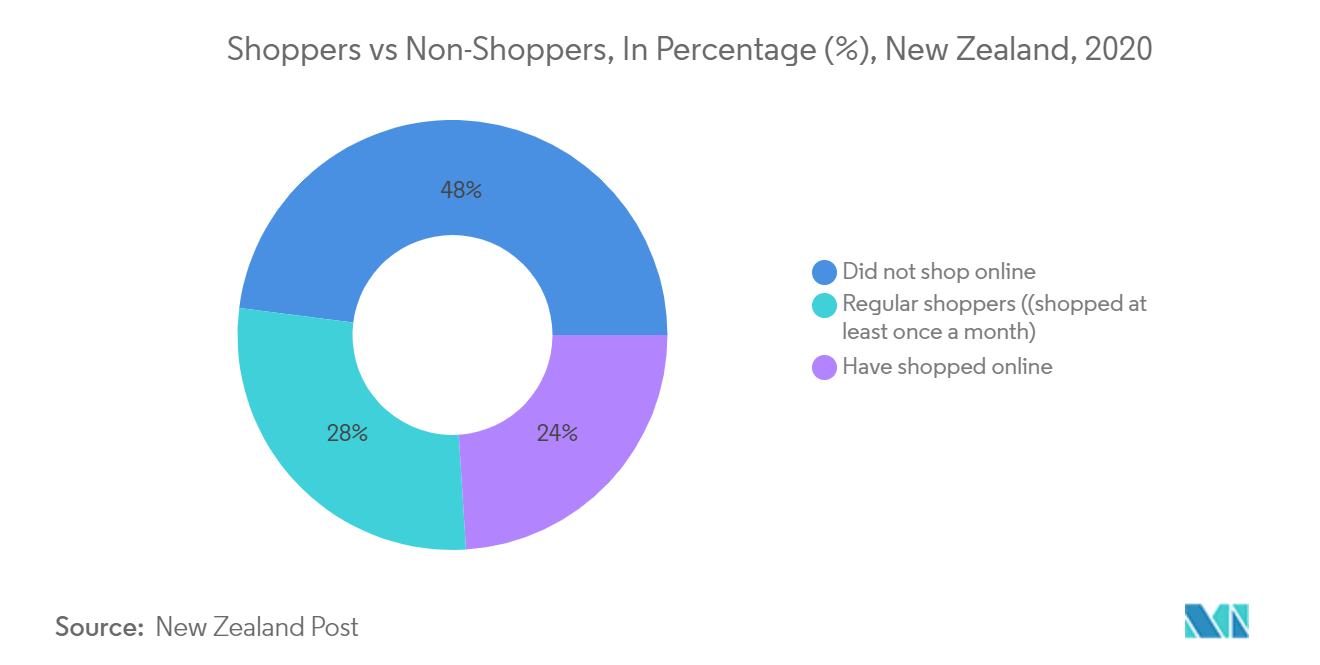
Clothing, Footwear and Fashion Segment is Expected to Drive the E-commerce Market
- The fashion sector in the New Zealand e-commerce market is constantly changing, driven by trends, exchange rates, delivery speeds, and cost, and increasingly influenced by finance offers by the major E-commerce companies in the region.
- Furthermore, the growing adoption of digital advertising on social media platforms like Facebook, Instagram, and Pinterest driven by coupons and discounts is further attracting and appealing to the consumers in the region to go for clothing and footwear purchasing through E-commerce.
- As reported by New Zealand Post, the clothing and footwear segment was up an impressive 37% in Quarter 3 of 2021 compared to Quarter 3 of 2020. The clothing and footwear sector saw its year-to-date spend up 25% compared to last year.
- Furthermore, the growth in numbers of clothing and footwear also showed a strong correlation between the growth of the younger age groups online, which are more active in online shopping of fashion products, and the growth of sectors like Buy Now Pay Later, which are over-represented by the younger age groups. This trend is further expected to grow over the forecast period.
- All of the aforementioned factors are further expected to boost the demand for clothing, footwear, and fashion products in the e-commerce market over the forecast period.
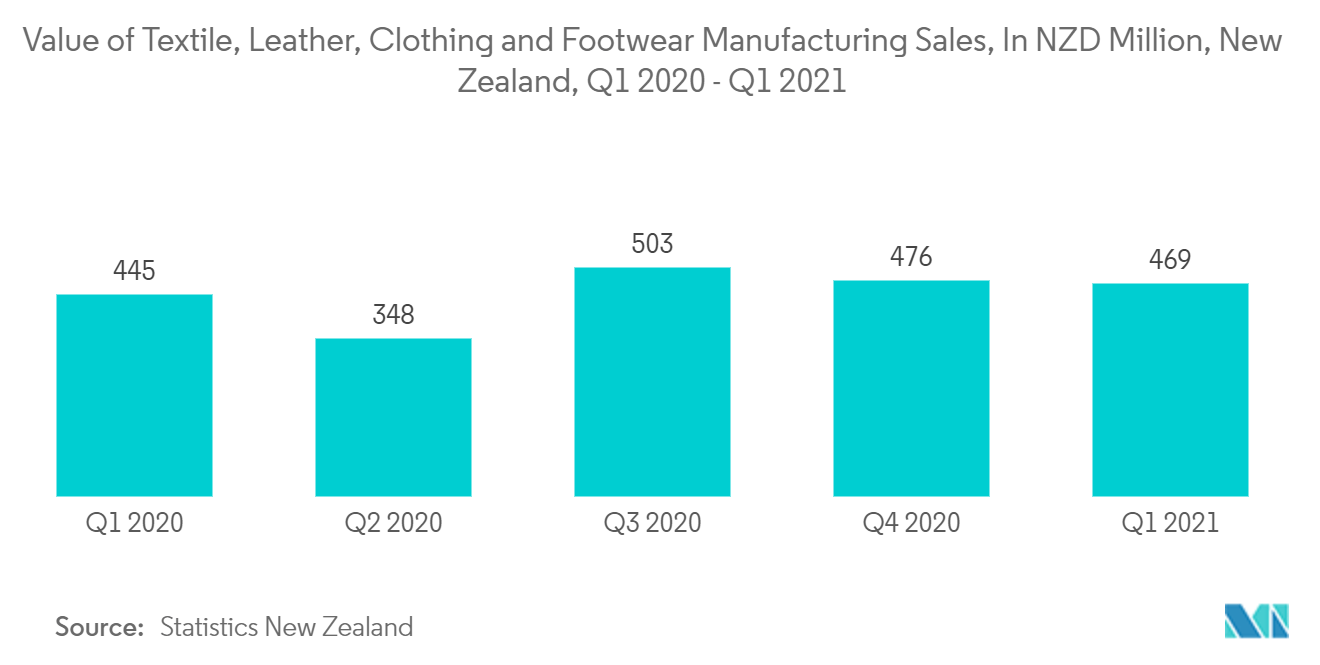
New Zealand Ecommerce Industry Overview
The New Zealand e-commerce market is highly competitive and fragmented with the presence of several players such as Countdown.co.nz, Trade Me, FishPond Ltd., Farmers, etc. The major players in the region are increasing their presence in the market by introducing new offerings and entering into strategic partnerships or acquisitions.
- January 2022 - NZ Compare announced the acquisition of the international, data-led, e-commerce comparison shopping business, PriceMe. PriceMe will complement the existing NZ Compare comparison websites Broadband Compare, Power Compare & Money Compare, and our online voucher site FreeVoucherCodes.co.nz. The acquisition will round out our comparison business and allow us to service an expanding client base and reach even more shoppers with the very best offers, deals, and promotions.
- February 2022 - Fashion e-commerce retailer Boohoo has branched into vegan beauty, launching a 50-product range across makeup and beauty. The launch of its vegan beauty range will showcase products inclusive of all complexions and skin tones, as well as a variety of kits, such as 'The Bronzed Glow' and 'The Brow Shape' set to reach customers keen to explore the latest makeup trends from TikTok and other social media websites.
New Zealand Ecommerce Market Leaders
-
Countdown.co.nz
-
Trade Me
-
Farmers
-
The Warehouse NZ
-
Fishpond Ltd.
*Disclaimer: Major Players sorted in no particular order
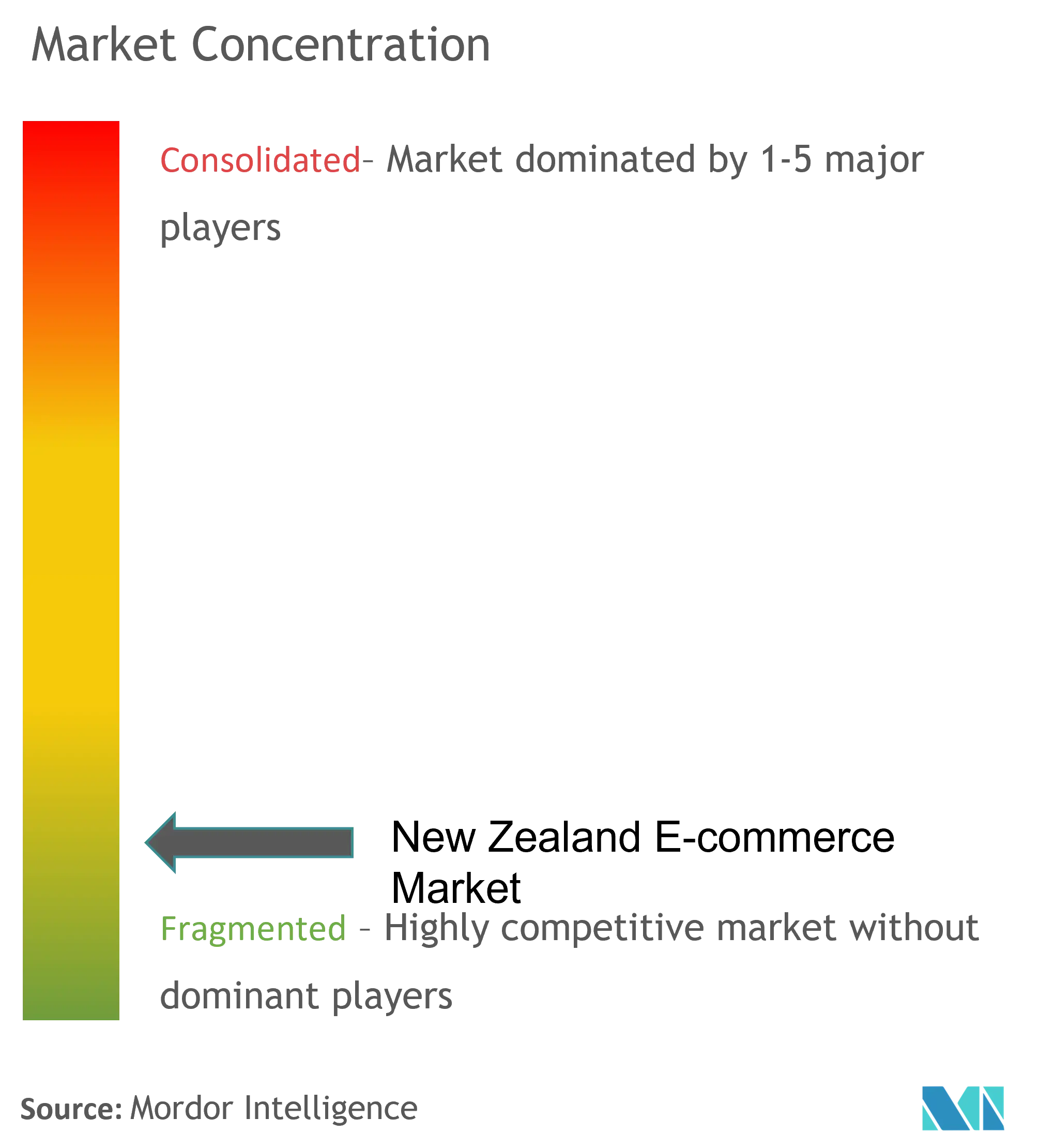
New Zealand Ecommerce Market News
- March 2022 - Australian e-commerce company MyDeal announced its plans to expand into New Zealand during the first half of the calendar year. After that, the company is eyeing moving further abroad, entering the UK and the US markets.
- April 2022 - A whiteware, furnishings, and equipment retailer modeling itself on the likes of e-commerce giant Amazon within a single day supply has launched in New Zealand. Andoo, an e-commerce-only retailer arrange by Australian brick-and-mortar retail, is currently able to offer next-day delivery in the Auckland and Hamilton region to grow that nationwide.
New Zealand Ecommerce Market Report - Table of Contents
1. INTRODUCTION
- 1.1 Study Assumptions and Market Defination
- 1.2 Scope of the Study
2. RESEARCH METHODOLOGY
3. EXECUTIVE SUMMARY
4. MARKET INSIGHTS
- 4.1 Market Overview
-
4.2 Industry Attractiveness - Porter's Five Forces Analysis
- 4.2.1 Bargaining Power of Suppliers
- 4.2.2 Bargaining Power of Buyers/Consumers
- 4.2.3 Threat of New Entrants
- 4.2.4 Threat of Substitute Products
- 4.2.5 Intensity of Competitive Rivalry
- 4.3 Key Market Trends and Share of E-commerce of Total Retail Sector
- 4.4 Impact of COVID-19 on the E-commerce Sales
5. MARKET DYNAMICS
-
5.1 Market Drivers
- 5.1.1 Increasing Online Shoppers is Expected to Boost the Market
- 5.1.2 Rising Adoption of Buy Now Pay Later Services
-
5.2 Market Challenges
- 5.2.1 Challenges Related to Local E-commerce Laws Including Consumer and Tax Procedures
- 5.3 Analysis of Key Demographic Trends and Patterns Related to E-commerce Industry in New Zealand (Coverage to Include Population, Internet Penetration, E-commerce Penetration, Age & Income etc.)
- 5.4 Analysis of the Key Modes of Transaction in the E-commerce Industry in New Zealand (Coverage to Include Prevalent Modes of Payment Such as Cash, Card, Bank Transfer, Wallets, etc.)
- 5.5 Analysis of Cross-Border E-commerce Industry in New Zealand (Current Market Value of Cross-border & Key Trends)
- 5.6 Current Positioning of New Zealand in the E-commerce Industry in Asia-Pacific
6. MARKET SEGMENTATION
-
6.1 By B2C E-commerce
- 6.1.1 Market Size (GMV) for the Period of 2017-2027
- 6.1.2 Market Segmentation - by Application
- 6.1.2.1 Beauty and Personal Care
- 6.1.2.2 Consumer Electronics
- 6.1.2.3 Fashion and Apparel
- 6.1.2.4 Food and Beverages
- 6.1.2.5 Furniture and Home
- 6.1.2.6 Others (Toys, DIY, Media, etc.)
-
6.2 By B2B E-commerce
- 6.2.1 Market Size for the Period of 2017-2027
7. COMPETITIVE LANDSCAPE
-
7.1 Company Profiles
- 7.1.1 Countdown.co.nz
- 7.1.2 Trade Me
- 7.1.3 Farmers
- 7.1.4 The Warehouse NZ
- 7.1.5 Fishpond Ltd
- 7.1.6 Kmart
- 7.1.7 Briscoe
- 7.1.8 MightyApe
- 7.1.9 Grabone
- 7.1.10 Priceme
- 7.1.11 Dicksmith
- 7.1.12 EziBuy.com
- *List Not Exhaustive
8. Investment Analysis
9. Future Outlook of the Market
** Subject To AvailablityNew Zealand Ecommerce Industry Segmentation
E-commerce or electronic commerce is the purchasing and selling of goods or services on the internet. It encompasses various data, systems, and tools for online buyers and sellers, including mobile shopping and online payment encryption. Most businesses with an e-commerce presence use an e-commerce store or an e-commerce platform to conduct online marketing and sales activities.
The New Zealand e-commerce market is segmented into B2C e-commerce and B2B e-commerce. By B2C e-commerce, the market studied is further subdivided into beauty and personal care, consumer electronics, fashion and apparel, food and beverages, furniture and home, and other product types. The study also tracks key market metrics, underlying growth influencers, and significant industry vendors, providing support for market estimates and growth rates in the region throughout the forecasted period. The study goes on to look at COVID-19's overall influence on the ecosystem.
| By B2C E-commerce | Market Size (GMV) for the Period of 2017-2027 | |
| Market Segmentation - by Application | Beauty and Personal Care | |
| Consumer Electronics | ||
| Fashion and Apparel | ||
| Food and Beverages | ||
| Furniture and Home | ||
| Others (Toys, DIY, Media, etc.) | ||
| By B2B E-commerce | Market Size for the Period of 2017-2027 |
New Zealand Ecommerce Market Research FAQs
What is the current New Zealand E-commerce Market size?
The New Zealand E-commerce Market is projected to register a CAGR of 8.70% during the forecast period (2024-2029)
Who are the key players in New Zealand E-commerce Market?
Countdown.co.nz, Trade Me, Farmers, The Warehouse NZ and Fishpond Ltd. are the major companies operating in the New Zealand E-commerce Market.
What years does this New Zealand E-commerce Market cover?
The report covers the New Zealand E-commerce Market historical market size for years: 2019, 2020, 2021, 2022 and 2023. The report also forecasts the New Zealand E-commerce Market size for years: 2024, 2025, 2026, 2027, 2028 and 2029.
Ecommerce in New Zealand Industry Report
Statistics for the 2024 Ecommerce in New Zealand market share, size and revenue growth rate, created by Mordor Intelligence™ Industry Reports. Ecommerce in New Zealand analysis includes a market forecast outlook 2029 and historical overview. Get a sample of this industry analysis as a free report PDF download.



